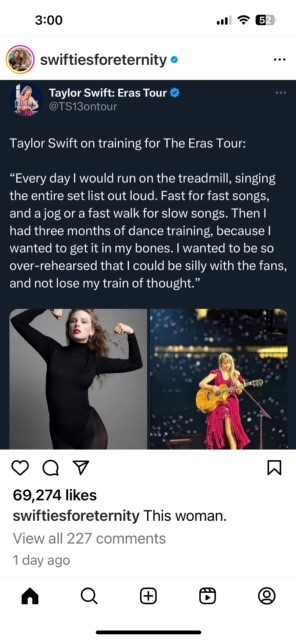12.08.23Teaching Advice From Taylor (Swift)

That’s exactly what we do too, Taylor!!!
A colleague who attended our recent workshop for medical educators, Josie Amory of Seattle, WA, passed along this Instagram post from Taylor Swift about her concert preparation routine:

“This insta post reminded me of the discussion we had about working memory and habits good teachers use to reduce their dependence on working memory, which in turn allows for more present moment situational awareness,” Josie wrote.
Can I just say that I could not agree more with Josie’s take on the “Wisdom of Taylor.”
One of the most important things teachers can do to be more responsive to and connected with students during a lesson is to prepare extensively so their own lesson is clear in their own mind and they can teach with a lessened load on WM.
Working memory is limited for teachers too and if you’re trying to think about your next question or the answer you hope you’ll get, you have less of that working memory left over to observe and react to your students.
“How will I manage my own Working Memory as I teach?” is one of the most important questions teachers can ask themselves.
And ironically, sometimes people think careful preparation makes you less flexible, but it does the opposite. It lets you be fully present during the lesson.
So to be like Taylor we suggest that teachers consider some or all of the following steps (sorry, no treadmill and dance moves):
- Plan your questions in advance. You can always change them but having them written in advance means you don’t have to use working memory to think of them while performing…er….teaching.
- Write out the answer you hope you’ll get to the most important questions you’ll ask in advance. By thinking about the answers you want in advance you won’t have to think about this as much when you’re teaching.
- Keep a written version of that answer with you so you can glance at it and refresh your working memory.
- Write down 2 or 3 likely mistakes or errors students are likely to make. You’ll notice them more readily if you’ve prepared to think about what you’re likely to see. Again this will let you search out misunderstandings with less load on working memory.
- Plan your “Means of Participation.” Don’t just plan your questions but plan how students will answer them. Will you use a Turn and Talk and then take hands for one question and a quick Stop and Jot backstopped by a Cold Call for another? Again keep these notes with you on a clip board. More preparation for your own moves means less thinking about it while live and more WM free to listen and respond to your students. I’m a big fan of Hicks’ Law which tells us that the time and working memory required to make a decision increases with the number of choices, so it’s useful to think of a menu of, say, four or five forms of participation you might use at any given time: Turn and Talk, Stop and Jot, Cold Call, Volunteers and maybe Call and Response. Then deciding what you ask student to do next is a simple task of selecting from a small menu of familiar routines. Result: Lessened load on teacher working memory.
- Use a clipboard to take notes of things students say during class. Remembering things they said that you want to come back to uses up a lot of working memory. Just jot them down and now your WM is free.
Lesson preparation in other words is different from lesson planning. Preparation is what you do to manage your Working Memory as you teach. With better preparation you can, in Taylor’s words, “be silly [or smart or thoughtful or responsive] with the fans without losing your train of thought.”
Good luck on stage!